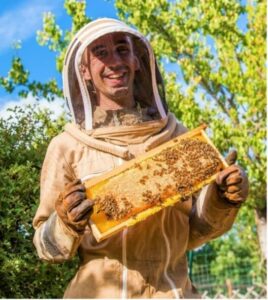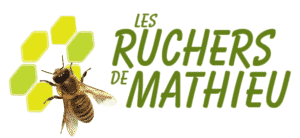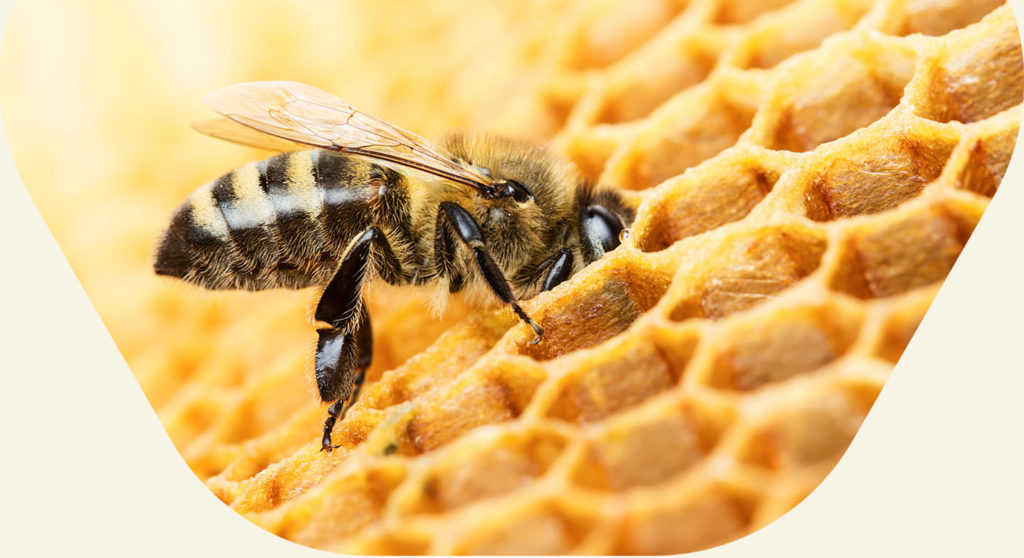API of the Month
Mathieu Domecq
Editor-in-chief of the API blog of the month
This July, a heatwave may hit the beehives in some regions! After a catastrophic start, things could still remain difficult if the flowers dry out. In this article, you will learn how heat affects bees, before we take a look at the basic equipment you need to visit the beehives.
Did you know that in 2023, France had 62,803 beekeepers for nearly 1.8 million beehives… declining numbers take us back to the 2018 figure. (Source)

This month’s work
July promises to be hot in some regions, with the risk of missing out on honey. Some beehives have recovered from the rainy spring when they lacked reserves and others are still suffering.
Here is a summary of the beekeeping work:
– Keeping an eye on the feedstock: Some colonies are still light when the lime and chestnut honey has not been enough to boost them: add a little Apiinvert syrup. A honey crown about 4 cm wide should be visible on top of the brood frames, indicating that the colony is able to stock up and that the queen is getting into a good laying rhythm.
– The heat: July and August may be extremely hot. Bees find it hard to tolerate this. You may see them in clusters in the evening at the entrance to the beehive: they are ventilating it. It may look like a swarm, but rest assured, there is no reason for them to leave the beehive. Instead, relieve them by placing insulation under the roof if you have not already done so!
– Install supers: with sunflower in particular, there may be strong inflows of nectar. Even with a super already in place, filling can accelerate and the bees may cramped. Prepare for this by placing a second super on top if there are only two or three frames left to fill in the first one.
– Trap hornets: hornets are going to start to land on the beehives. Place traps now to bait them and avoid stress for the beehives.
The honey flowers of the month: honey tree, lavender, sunflower.
The impact of heat on bees
Despite a rainy spring, a heatwave could come.
Think about yourself first! You will be hot if you wear a beekeeping suit and you may soon become dehydrated, so be careful! Check the beehives in the morning, ideally before 11 a.m.
The impact on the colonies? A large cluster of bees will form in front of the beehive, on the flight board: they are regulating the internal temperature to maintain it at 35°C for the brood. The bees’ wings beat no fewer than 200 times per second for ventilation! The bees gather at the entrance, which is what we call “bearding”. Do not try to get them inside, this is not a swarm. You will notice this phenomenon especially at the end of the day.

Bees will collect water and then distribute fresh air to create natural air conditioning. So make sure there is water nearby, within 50 metres of the beehive. If not, place a trough with twigs, tree moss or corks to prevent drowning.
The impact on the harvest? There is chestnut, lavender, then sunflower honey. Without water or morning dew, the nectar will dry out in the flower and the bee will not be able to come and forage from the flowers the next day. You may miss the honey harvest.
What do I have to do? Check your colonies by monitoring two points: the space in the beehive (add a super if necessary) and the feedstock (sufficient nectar present) that is brought in to feed the brood. If the colony is too light, feed it with Apiinvert syrup.
I also recommend that you insulate your beehive from the heat if it is not in the shade during this time. You can place plywood on the metal roof or plant shrubs behind your beehive, for example. Inside it, use an Apifoam type insulating foam to better regulate this temperature. You can find it in your local beekeeping shop.
Researchers have found that with a high temperature above 42°C in the beehive, the bees will start killing themselves if this heat persists for more than six hours. To find out more, visit our API website blog and read the article!
The basic equipment for visiting the beehives
Gloves should definitely be a part of the beekeeper’s equipment. They come in leather, latex, nitrile, etc. — it is not always an easy choice. They need to be comfortable while being very agile and precise at the fingertips. Leather is often chosen for this. On the other hand, latex can be easily washed with water once covered in honey.
Choosing between a beekeeping suit and tunic (or jacket). You might look like a superhero, but you should still wear the right clothing to protect yourself. Materials vary between cotton, nylon and triple knit. The latter is widely used and recommended in summer. It is an ultra-ventilated model where air easily passes through but not any stings. The beekeeper’s visor can also be round or astronaut shape… choose the one in which you feel most comfortable — it is a personal choice. And then do not forget to protect your feet with high-cut shoes or boots of course.

The frame lifter — a tool that must never leave your hand. Do not place it on the edge of your beehive or leave it in your pocket when visiting. It is a tool that should stay in the palm of your hand even when you are grabbing a frame in the same hand. There are lots of shapes and options: scrape, lift, split, with hammer, hooks, wooden handle, etc. Choose a lightweight and easy-to-handle model.
How could we forget the smoker? Never open a beehive without it. It is your best ally with bees, especially when it comes to aggression. As a reminder, its smoke warns the bees and calms them by simulating a fire. In shops, its price can sometimes triple! The quality follows suit. It all depends on how often you use it, whether you have one or a hundred beehives. But do not overlook the quality aspect when you buy it. Choose a strong one, with good leather bellows (on cheap products, they often tear). Your beekeeping supplier will be happy to advise you.

Finally, the bee brush… which enables you to gently remove them from the super frames for the honey harvest. You can still choose between nylon or horsehair. As a tip, nylon is less susceptible to damage and easier to clean.
As usual, share your photos with us. We shall publish them on our website from social media with the hashtags #apifonda #apiinvert!
We will be back next month on the API blog with your faithful partner, Les Ruchers De Mathieu!

LES RUCHERS DE MATHIEU
Honey & Beekeeping Shop
Photos ©lesruchersdemathieu


